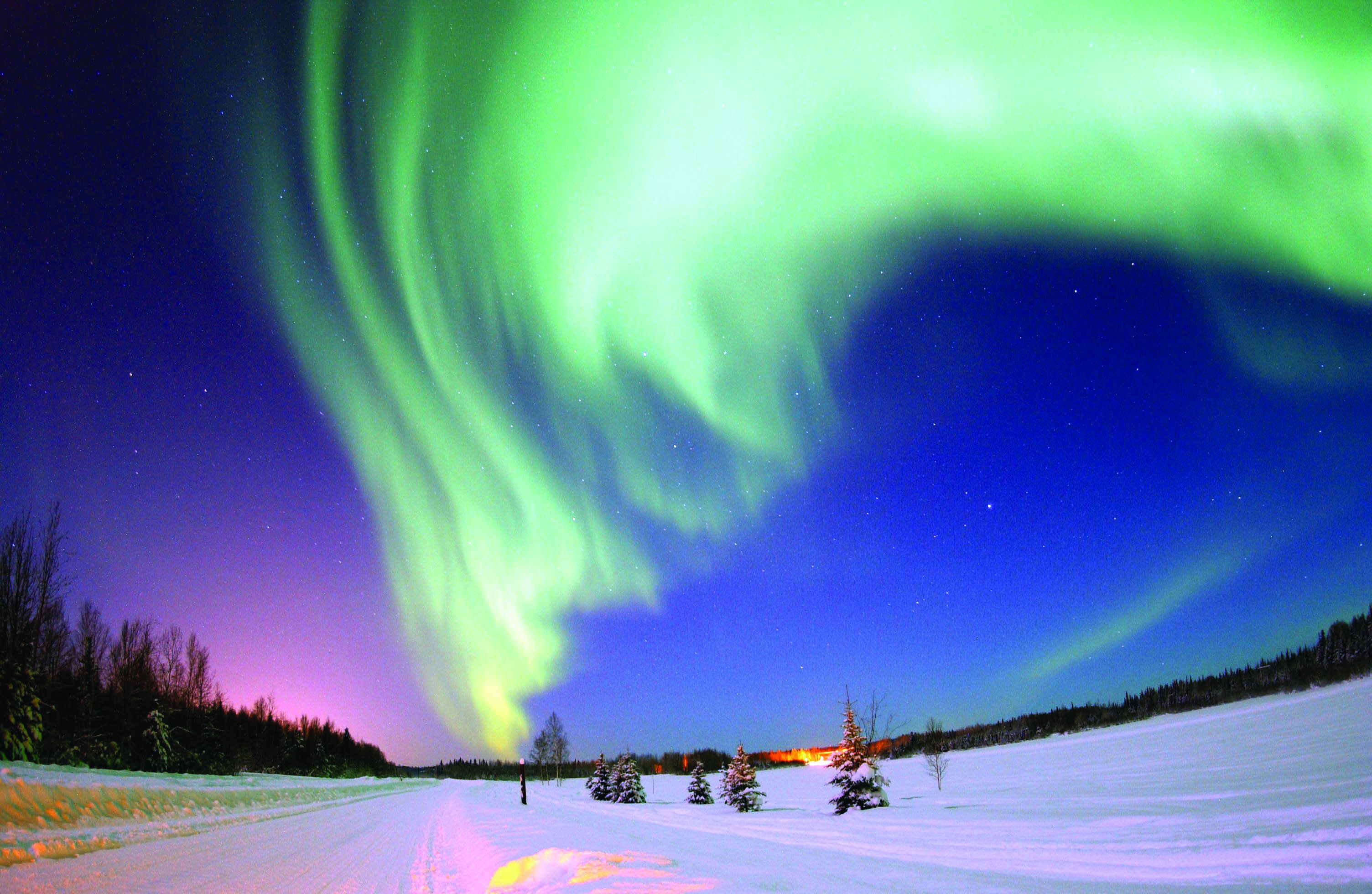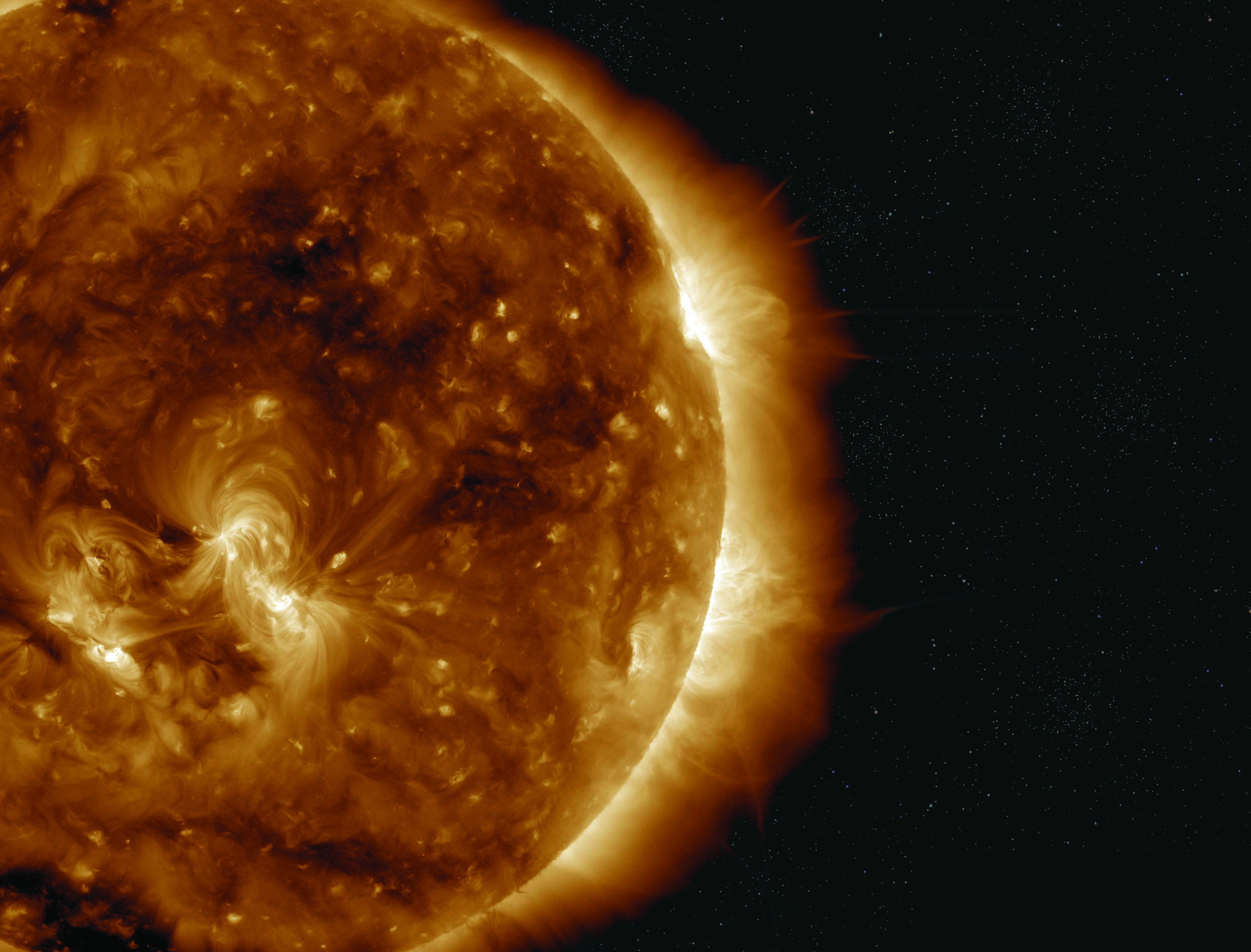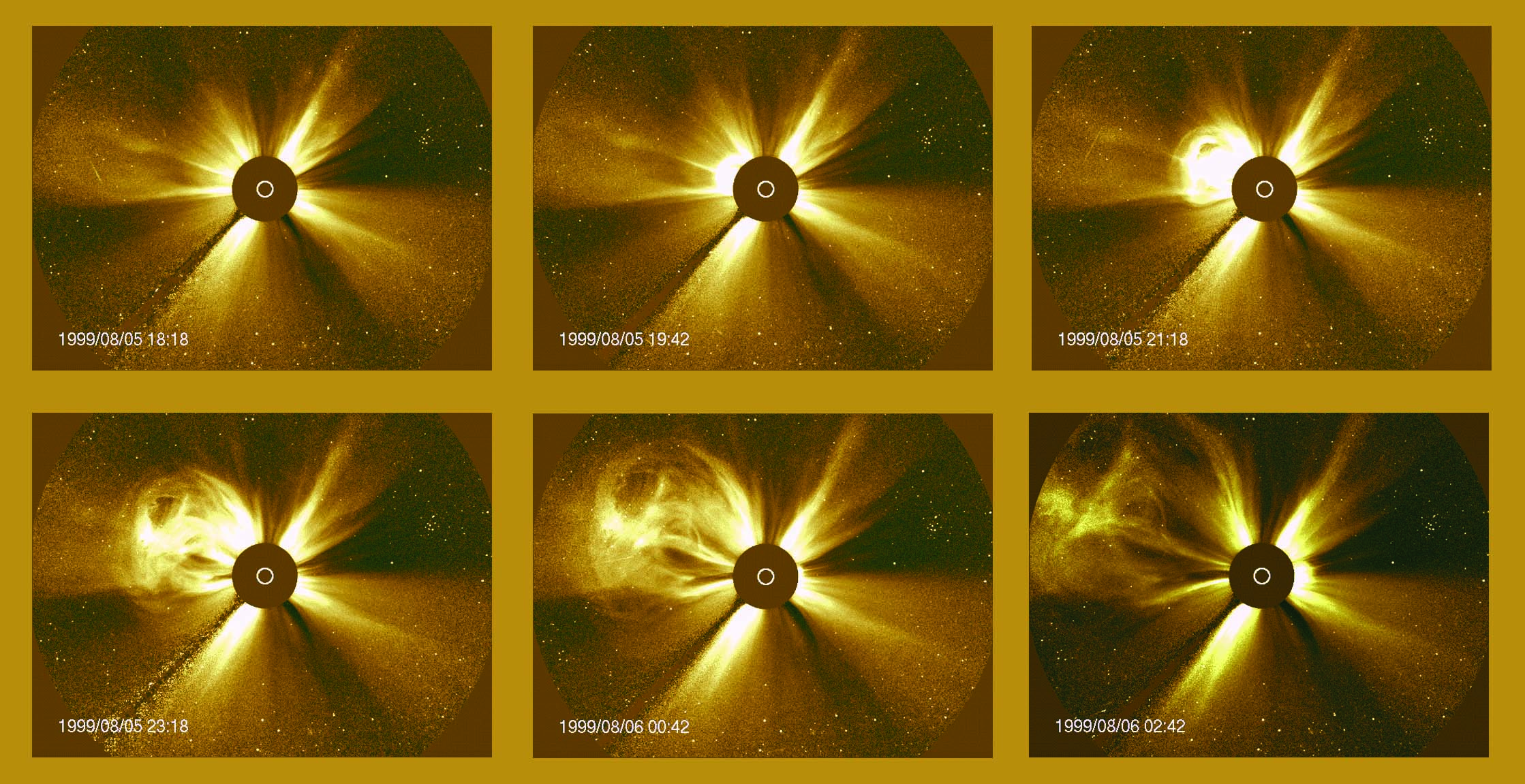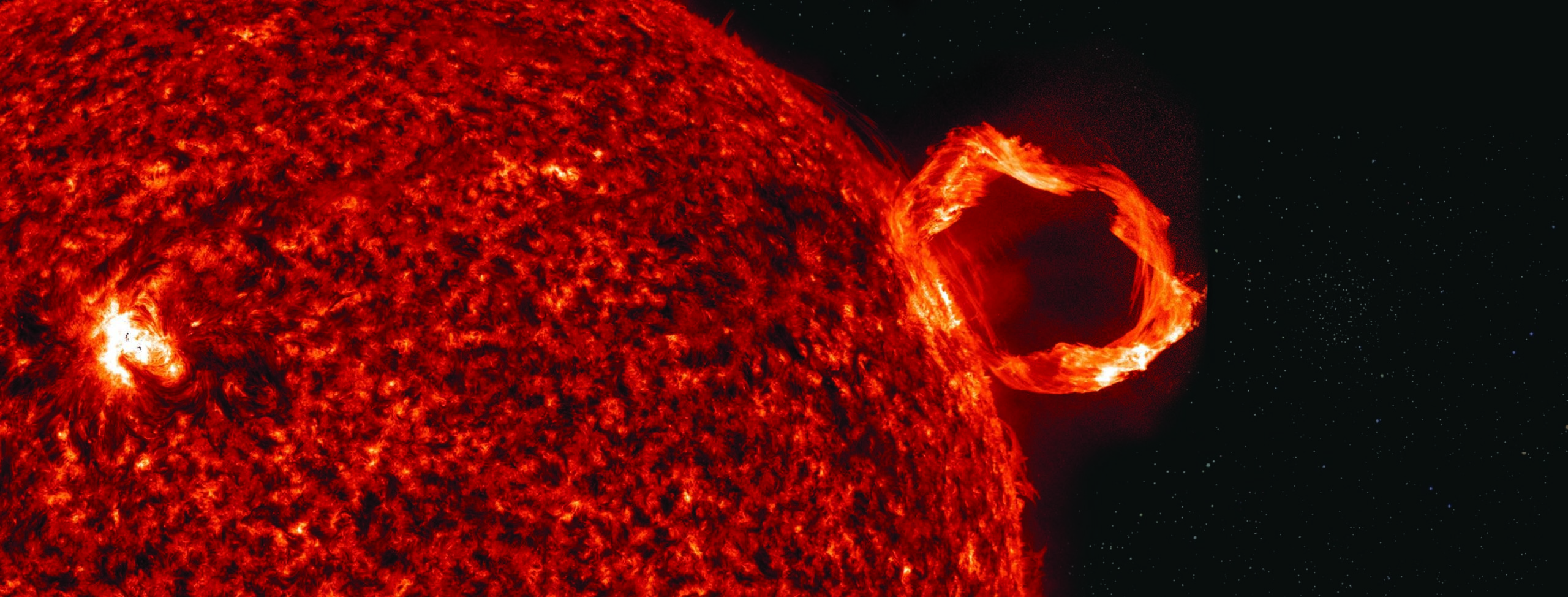Researchers at UMBC’s newly formed NASA research center wrestle with basic questions about our neighborhood star – and the effects that its weather can create on Earth.
By Anthony Lane
On the morning of September 1, 1859, a British solar astronomer was using his telescope to look at a projected image of the sun when something strange happened: Two brilliant patches of white light pierced the thicket of sunspots he’d been tracking.
Richard Carrington, the astronomer, was astounded by what he saw. He scrambled outside to find someone to join him as a witness to the amazing spectacle, but by the time he’d grabbed a bystander and returned a minute later, the solar eruption was nearly over.
Carrington’s account of the event might have been ignored or forgotten were it not for a much more widespread spectacle that commenced about 17 hours later. Auroras – which are normally seen only from the planet’s far north and south extremes – laced the night sky above Cuba, El Salvador and Hawaii. And according to a whimsical account in the Baltimore American and Commercial Advertiser, Marylanders saw an aurora that shined brighter than a full moon, appearing to “cover the whole firmament, apparently like a luminous cloud, through which the stars of the larger magnitude indistinctly shone.”

But the beauties of that 1859 light display masked the minor destruction wrought worldwide by an event that scientists now say was a once-in-every-500-year solar flare. As strands of light pulsed overhead in the early morning of that September day, Earth’s changing magnetic field induced electric currents within telegraph wires. Some transmissions were blocked, and fires erupted at a few telegraph stations. Aleksandre “Sandro” Taktakishvili, a researcher and space weather forecaster at UMBC’s newly formed Goddard Planetary Heliophysics Institute (GPHI), observes that if such an event were to occur today, the results could be calamitous. He speaks in hushed tones about the likelihood of damaged and destroyed satellites, overloaded power grids, and useless GPS devices.
“It would be devastating,” Taktakishvili says. “The more dependent we are on satellites, the more vulnerable we are to these events.”
Fortunately, our knowledge of the sun and its capacity to hurl masses of plasma toward Earth has come a long way since 1859. Taktakishvili, who works with other GPHI researchers at NASA’s Goddard Space Flight Center, is part of a rotation of scientists at NASA charged with monitoring the sun’s activity and forecasting what impacts it could have on Earth or on the satellites that orbit around it. He has live access to streams of data
coming from a battery of instruments trained on the sun, and, based on that information, he is confident he can predict the impact that routine solar flares and coronal mass ejections (CMEs) will have on Earth.
Taktakishvili admits that he and other scientists at GPHI, NASA and in the broader research community still have much to learn about how the sun produces flares such as the one that Carrington observed in 1859 – as well as the ways in which such events can play havoc with Earth’s magnetic field.
“With the monitoring we have, we are pretty well prepared,” Taktakishvili says. “Still, you cannot exclude the possibility of something major happening.”
TRACKING SOLAR WIND
Despite the possibility of damaging solar events, Jan Merka, director of GPHI, sounds a more soothing note when he talks about the lucky constellation of events that put Earth in just the right position in relation to the sun for life to thrive on this planet.
“Earth is a homey place,” Merka observes. “We need some radiation, but not too much. We need it to be warm, but not too warm.”
Earth’s magnetic field is an essential part of its suitability for life. Produced by the movement of molten iron in Earth’s outer core, the magnetic field effectively guards the planet against solar wind – a constant barrage of charged particles hurled from the sun. Without that protection, solar wind would have long since stripped away much of the planet’s atmosphere, making Earth a dreary and inhospitable place.
In the absence of solar wind, Earth’s magnetic field would send out an expanding and uniform series of field lines stretching from north to south. A drawing of this field would show lines organized in the sort of lobed race-track pattern that iron filings make when strewn around a bar magnet.
The solar wind, however, distorts the magnetic field, giving it a complex, changing form known as a magnetosphere. Artists’ renditions of the magnetosphere sometimes make it look like a ghostly octopus, with a small head facing the sun and spindly legs stretching out into the solar system.
The 16 scientists at GPHI investigate a range of topics related to solar activity and the magnetosphere. Taktakishvili and several others are concerned with making better forecasts and observations of solar events, providing information that can be used to protect satellites or inform decisions about how close airplanes should fly to Earth’s magnetic poles, where charged particles from the sun are most likely to work their way into the atmosphere.
The risk of illness or even death for those exposed to these particles is a particular challenge for space travel, making better predictions very important, especially in the event that a space crew ever ventures out from the relative safety of the magnetosphere for a months-long journey to Mars.
Other scientists at the institute work with teams that are analyzing data sent from the MESSENGER spacecraft orbiting Mercury or other NASA missions aimed at deepening human knowledge of solar activity and its impacts. Merka talks excitedly about seemingly basic questions that researchers still haven’t answered about solar phenomena. For instance, why and how are charged particles quickly accelerated to speeds of several hundred or even thousands of miles per second after they leave the sun?
“We need to understand all the pieces to reliably simulate space weather and make good predictions,” Merka says.
Merka’s own research delves into the complexities of solar wind and the interactions that occur when this torrent of charged particles collide with Earth’s magnetosphere. In the absence of major solar activity, solar wind can be relatively gentle, with particles cruising through space at about 250 miles per second before being slowed and redirected by Earth’s magnetic field. But things get more interesting when particles kicked out during solar events such as solar flares or coronal mass ejections speed through space at much greater speeds.

These fast-moving particles plow past their leisurely cousins. The result, Merka explains, is much like what happens when a jet breaks the sound barrier in Earth’s atmosphere. The sonic “boom” you might hear living next to an Air Force base is actually a shock wave that results from air not being able to get out of a speeding plane’s way fast enough. This forms a sharp boundary between the undisturbed air and air that has piled up in front of the plane. In space, there’s no boom anyone could hear. Instead, charged particles pile up in front of the faster-moving sections of the solar wind. This produces an “interplanetary shockwave,” accelerating particles that can then slam into Earth’s magnetosphere and force it to reconfigure.
Predicting and modeling these shocks is one challenge. Another challenge is understanding what happens when solar wind comes in range of Earth’s magnetic field. Just as charged particles pile up when fast sections of solar wind encounter slower parts, the particles start to pile up when they encounter Earth’s magnetic field and need to find a way around it. This forms another shock wave that scientists refer to as the “bow shock.”
In artists’ renditions, the bow shock often looks like a massive deflector shield from a Star Trek episode. Things aren’t totally calm behind it, however. Solar wind slows, compresses, and then heats up at the bow shock, becoming turbulent in a region known as the magnetosheath. Moving closer to Earth, the pressure from the solar particles gradually decreases until it is balanced by the outward pressure exerted by Earth’s magnetic field. The magnetopause is the final boundary beyond which relatively few particles can penetrate.
Understanding how these layers react when the barrage of particles intensifies due to solar storms and interplanetary shocks is critical for predicting the impact these events will have on satellites, power grids and a host of other systems that people on Earth care about.
GPHI scientist Yongli Wang, who works with Merka and other scientists at NASA to accurately model these changes, explains that current modeling techniques face serious limitations. To understand changes in one layer, he frets, scientists have had to treat the others as unchanging or make simplifying assumptions about their shape.
Wang believes that an alternative he is developing with Merka and other colleagues will allow scientists to “forget about assuming structure.” They are working on a new technique which will allow scientists to deal with all the layers simultaneously, drawing on a database that catalogs a wealth of satellite observations collected over four decades. Just as meteorologists have developed ever better models to understand and predict the intensification of hurricanes as they cross Earth’s oceans, Wang and Merka are putting finishing touches on a model that makes sense of data from solar storms. Such a model should help scientists at NASA and elsewhere more accurately predict both the course and consequences of these events.
“This is the golden key to solving this problem,” Wang says.
OBSERVING CYCLES
The prospect of new discoveries in the developing research field of space weather isn’t limited to tracking solar wind and eruptions on the sun.
Keith Strong, a GPHI scientist affiliated with the University of Maryland at College Park, describes a different set of challenges associated with understanding and predicting solar activity. Scientists have known for more than 150 years that solar activity waxes and wanes in cycles of about 11 years, but the mechanism that controls the sun’s magnetic activity – and ultimately produces this cycle – remains a mystery.
“That’s the holy grail of solar physics,” Strong says.
Finding that grail is not just an interesting task for researchers. Sunspots regularly appear on the sun’s surface as small, dark patches. Scientists now know that these patches are associated with intense magnetic activity which reduces the amount of energy escaping. That’s why the spots appear dark: Sunspots are actually cooler than neighboring parts of the sun with weaker magnetic fields.

Even with limited understanding of what causes these spots, astronomers have monitored and tracked them for more than 400 years. And for a 70-year period ending around 1715, there was relatively little such activity for these astronomers to see: The sun had entered an extended period of limited activity that is known as the Maunder Minimum.
Scientists debate the extent to which this period of minimal solar activity can be linked to an extended cold snap beginning around 1650 that brought decades of abnormally rainy summers and cold and snowy winters to Europe and North America. And how and why solar activity ebbed during this period is also a mystery.
More recently, the solar cycle that started in 1996 dragged on for 12.6 years, petering out only near the end of 2008. Predictions about the new cycle have repeatedly been wrong, Strong notes, highlighting the gaps in our knowledge: “It is fascinating to realize how little we do understand.”
Ascertaining the underlying mechanism of solar activity could be a huge asset in protecting our satellites and communications systems. It will also be critical if we ever embark on a new phase of space travel. A trip to Mars, for instance, would take about two years, and astronauts during that time could be exposed to potentially lethal streams of high-energy charged particles. Being able to predict when solar activity will be at a minimum will be critical.
Despite its tendency to belch vast quantities of high-energy particles during solar storms, the sun is a much less volatile neighbor than many other stars in the galaxy. As Merka notes, our sun’s relative consistency has been essential for life on Earth to develop. With astronomers discovering an increasing number of planets in orbit around distant stars, Strong says, the ability to recognize the signature of equally stable stars could serve as a “Rosetta Stone” for picking likely candidates to support life.
“By understanding variability,” Strong says, “we might be able to understand what planets could be habitable.”
Since March, Strong has been sharing his fascination with a potentially unlimited audience by posting daily videos on YouTube under the username “drkstrong.” Each episode of “The Sun Today” lasts about five minutes as Strong guides viewers through a series of observations about recent solar activity and explains the mechanics of such events as solar flares and coronal mass ejections (CMEs).
On Aug. 2, Strong began his program with exciting news: “We’ve had a proton flare!” He notes it was a significant, though not unusual flare, and he quickly segues to the day’s trivia question: “How many times brighter than this… flare was the largest flare ever observed by astronomers?” Strong goes on to show data and images from a variety of NASA instruments and satellites, with animations illustrating the blast of charged particles surging into space. At the end of the program, he answers the trivia question, recalling that the observation of the largest flare ever was made six years ago by astronomers looking at the star II Pegasi. That flare, Strong says, was 100 million times larger than the one just observed on the sun.
“That would have had some very serious consequences for the Earth,” he observes. “Like, our civilizations would probably be reduced to rubble, assuming any of us survived.”
But you needn’t worry about that happening here on planet earth. At least not yet.
“Just be thankful,” he says, “that we live around a star that is quiescent enough that we survived, but variable enough to be interesting.”
* * * * *
Web Extras
Complex Solar Eruption
Having a Solar Blast
Spacecraft Observes Coronal Mass Ejection
Tags: Aleksandre Taktakishvili, Fall 2011, GPHI, Jan Merka, Keith Strong, NASA, Yongli Wang

